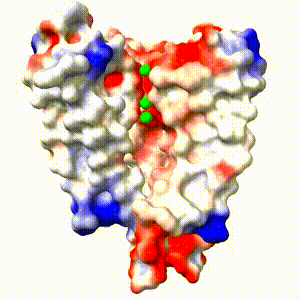Proteopedia:Featured EDU/6
From Proteopedia
(Difference between revisions)
| Line 15: | Line 15: | ||
Above is an integral membrane potassium channel protein. One of its 4 identical chains is removed so you can see the <b><span class="text-red">Negative (-)</span></b> | Above is an integral membrane potassium channel protein. One of its 4 identical chains is removed so you can see the <b><span class="text-red">Negative (-)</span></b> | ||
protein surface contacting the | protein surface contacting the | ||
| - | <b><span class="text-lightgreen">3 K+ ions</span></b>. | + | <b><span class="text-blue" class="bg-lightgreen">3 K+ ions</span></b>. |
Revision as of 00:48, 7 December 2024
Make Your Own Electrostatic Potential Maps
Positive (+) and Negative (-) charges on the surface of a protein molecule play crucial roles in its interactions with other molecules, and hence in its functions. Electrostatic potential maps coloring the surface of a protein molecule are a popular way to visualize the distribution of surface charges. Easy to use free software is available to to create these surface maps. Above is an integral membrane potassium channel protein. One of its 4 identical chains is removed so you can see the Negative (-) protein surface contacting the 3 K+ ions. |


